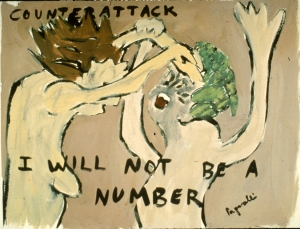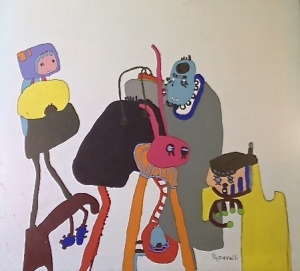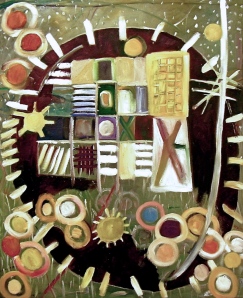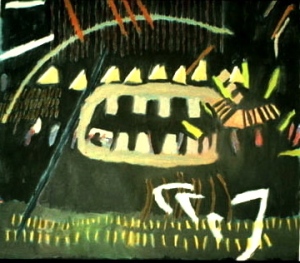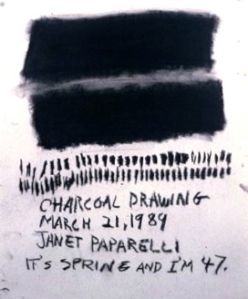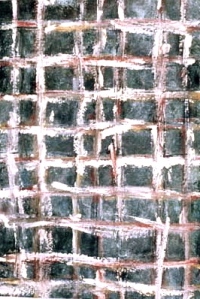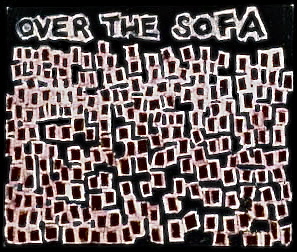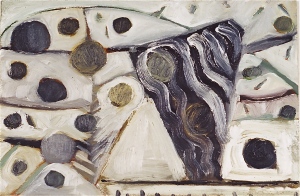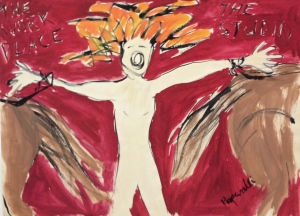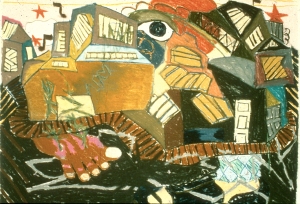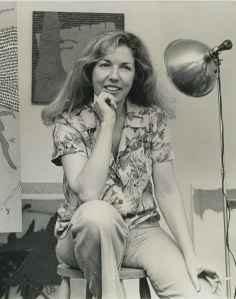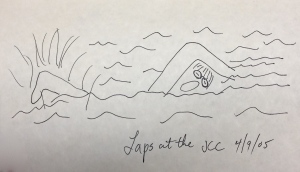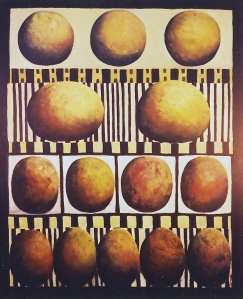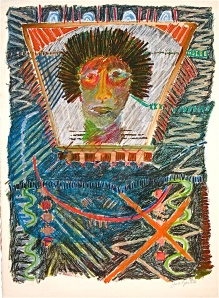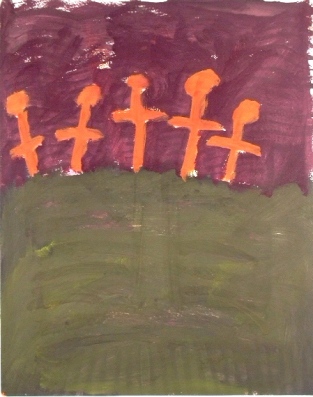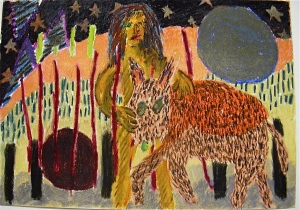
Me and the Art Dog 2/82
Pastel on Paper 9.5″x13.5″
In writing about the subject of painting with abandon, I can foresee myself writing my way into a corner. As I mentally browse my work of the last 35 plus years, I ask myself a previously unasked question, i.e. which ones of these would I designate as having been realized with abandon.
Living with abandon in the real world could be, at its worst, perilous, and at its best, messy.
Counter Attack Nov. 1984
Tempera on Paper 18″x24″
What works in fine art, doesn’t work in life and vice versa.
I usually march to the beat of that famous distant drummer which most successful people (air quotes) and even some artists don’t hear. So, as usual, I am writing for an extremely small audience with whom I may have something in common.
Talking Around It (1971) (Or: My Audience is Getting Smaller & Weirder Every Day)
Acrylic on Canvas 36″ x 30″
Immediately I think of a canvas that I call Almost Happy — I remember painting it.
Almost Happy Nov. 2001
Oil on Canvas 66″x54″
I remember standing in front of the blank canvas thinking: ” I don’t want to do any sketches or preparatory drawings. I won’t draw on the canvas itself– I will just attack it” , leaving self somewhere behind and using myself only as an instrument through which color and form pass–not evaluating as I go, not thinking about what’s going to happen, but allowing things to happen from the beginning of the painting to the end of the painting. The larger the work the more difficult to access and maintain abandon to the work’s completion.
In beginning a painting, the first mark, the first color and the placement of either one of those, the size of the canvas, or other surface on which one is working, can dictate one’s direction. One is almost compelled to follow a certain path depending on which mark, color, or material one has applied moments before. It’s as if one owes something to that mark or color etc. to complement it, to balance it. Abandon means not to pay attention to any of that.
Biting In Dec. 1981 [Yikes! This definitely screams “abandon”!]
Oil on Canvas 26″x28″
To paint with abandon is to not owe anything to the marks one made moments before. You don’t owe them anything. Approaching painting in this way, one must decide to be fearless at the outset and continue to be fearless ’til the end.
Action, and not thinking, dominate over judgment and decision-making.
It’s Spring and I’m 47 1989
Charcoal/Paper 17″x14″
Action, sadly, is a word loaded with images of paintings from the 1940’s, a term which carries baggage built up over the years by the peripheral people in the arts (curators, writers, professors, etc.) whose opinions and terminologies have overshadowed the words of the artists, themselves, in describing their own works.
Torn Grid (1999)
Oil on Paper 11.75″ x 8″
The preconception of having a strong idea of what a good painting is, can result in producing a rather mediocre work of art.
It’s an idea that works against one, in that one tries to comply with the preconception, which never results in originality.
Over the Sofa Sept. 1989
Oil Bar/Paper 26.5″x31″
I have done some mediocre work which owes itself to having been victimized by my having tried to comply with this idea, i.e. the preconception of what a good painting is. It’s a tricky thing–kind of sneaks up on one. Sorry, but I couldn’t find any mediocre work to insert in this text.
[“Too bad”, said she, and she cried all the way into posterity.]
White Painting with Triangles 2002
Oil on Panel 12″x18″
Trying to make a good painting results in not being able to make a good painting. The ideas of success or failure in what one does shouldn’t even enter into it. Approval, disapproval, understanding, analyzing, self-importance, painting for some future unknown audience, are not part of this. These are accessories piled onto art work by the peripheral colony of the auxiliary arts professions previously exampled (previously mentioned above, i.e. critics, professors, etc.). One just does the work.

TAXI 7/82 (Paris)
(Alternative title: I’m the Curator! No! I’m the Curator!)
Oil Crayon/Paper 22.5″x30″
One can be so trapped in one’s own confinements acquired over the years, that departing from them by stepping off into the nothingness and deep space of the unfamiliar can be quite an uncomfortable experience. It is difficult to be fearless, but it is worth the effort nevertheless.
Drawn & Quartered 1984 (Alternative Title: The Paparelli Scream)
Tempera/Paper 18″x24″
In reviewing the works I’ve done over the years, I’ve tried to identify those I’ve done with at least some fearlessness, the fearlessness to which I am also referring as abandon. I haven’t looked at my work with that criteria in mind thus far, but writing this post led me to scour my photos. The result is that I found many works done over the years which actually do comply with my definition of working with abandon. That was a happy surprise, actually.
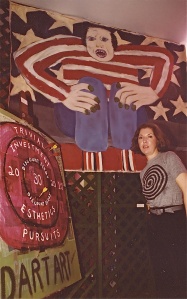 Janet Paparelli with Art Dart Board, an audience participation piece involving free, throwing darts, Oil and Collage on Particle Board and Silent Majority, Oil on Canvas, 70″ x 90″, both works, 1984)
Janet Paparelli with Art Dart Board, an audience participation piece involving free, throwing darts, Oil and Collage on Particle Board and Silent Majority, Oil on Canvas, 70″ x 90″, both works, 1984)
Inaugural Nada exhibition at the Coral Cafe on Coral Way, Coral Gables, Florida.
(1984)
——————————————-
Let’s call this the How To Section:
Cityscape with Large Eye (Paris) July 1982 [My subconscious must have been a real mess in 1982.]
Pastel on Paper 22.5″x30″
How does one know if one is working with abandon?
One is completely unaware of the world around one, of why one is choosing one action over another–every mark one makes is a surprise. There’s a sense of pleasure and enjoyment, in every action, every color selection, every mark. There is no sense of concern about composition or of artifice such as proportion, values, brushstrokes–anything at all that might inhibit the doing. There’s a sense of joy and there is no hesitation, no going over things relentlessly in one’s mind. There is just action and happiness, action and fulfillment, action and result.
That’s how it feels. No sitting on a stool looking at the work for an hour and then running up to the canvas and making a mark.
Artist on Studio Stool Miami, 1980
You just move through the painting the way you would move through water as you swim with ease. Being part of the water. The experienced swimmer doesn’t have to think of form after having lots of experience, the rules do become part of one,
Ball point pen sketch in an old journal.
However, unlike swimming, when one forgets the rules in doing art, one doesn’t sink, but rather, rises to the surface and hopefully, rises above the surface.
Golden Spheres (8/10/94)
Alkyd on Canvas 66″ x 54″
Did I write myself into a corner?
20th Century T.V. Reflection Jan. 1982
(Alternative Title: Where Am I? Where Am I?)
Pastel, Water Color, and Oil Pastel on Paper 30″x22.5
Janet Paparelli’s journals and writings have been requested by the Smithsonian Institution to be included in their collection of artist’s papers and writings, known as The Archives of American Art. In 1996 a representative of the Smithsonian spent a couple of hours at Paparelli’s studio, viewing journals and visuals with text which had been recommended for inclusion in the archives. After some time, spent in silence, the Smithsonian representative browsing through journals while sitting at a drafting table, Paparelli waiting in silence, interrupted: “Is this the kind of work you are looking for?” Happily the answer came back: “Yes. This is exactly what we are looking for.”
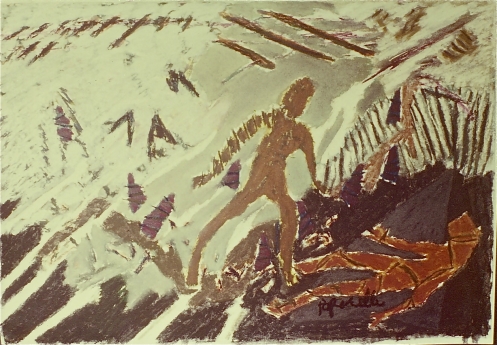
Discovery & Release; Pastel on Paper by Janet Paparelli; 10″ x 14″;
December, 1980; Private Collection
It took me only four tries during the course of a year to get into this first “text” : “The Expelled”. The reading was difficult before I found the key. I liked some of the phrases as poetic philosophical notes, and so underlined them with a green pencil, e.g. Memories are killing. So you must not think of certain things…That is to say, you must think of them for a while, a good while, every day several times a day, until they sink forever in the mud… & What must it have been like then for the man I had overgrown into…& So, for once, they [his landlords] had confined themselves to throwing me out and no more about it. I had time, before coming to rest in the gutter, to conclude this piece of reasoning...& But it was merely my hat sailing towards me through the air, rotating as it came. I caught it and put it on. They were most correct, according to their god…
I also wrote comments as thoughts occurred to me, e.g. Even if one is not thrown out of the house physically, but made to leave in a more surreptitious way, it is as Beckett writes, that one is thrown down the stairs–to hurt on the sidewalk–and then, while lying there, told to take your hat with you.
Then: Beckett: When my father died I could have got rid of this hat, there was nothing more to prevent me, but not I…
Me: When the enforcer dies, we enforce ourselves.
Me, again: Unlike Beckett, I was not thrown out, but escaped. Even after years of conditioned fear, I had to run.
Beckett: I felt ill at ease with all this air about me, lost before the confusion of innumerable prospects.
From Beckett’s ending: I don’t know why I told this story. I could just as well have told another.
* …Taking a hint from Edward Albee, I read the first part slowly & aloud. [that was my key to getting into it]. Albee thinks that is the best way to approach Beckett. I liked taking my time–just being with the words. Beckett is so poetic in one way, yet so down to earth in other ways. I like the ending because I’ve come to think the same way, i.e. I could have done something else, but instead, I did “this”.
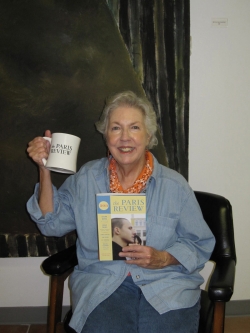
I’m so glad a friend turned me on to The Paris Review. My nephew said that it was wonderful that a person my age was still learning. Before he said that, I didn’t know I was old. The best thing about being old and subscribing to magazines is that you get a lot for your money. A month after I read something I forget what it was about and I get to read it all over again (two or three times actually).
I just read Samuel Beckett’s “Text for Nothing No. 1”. Now that is something which has to be read more than once. I read it four times. I underlined sections I liked. I looked up words I didn’t know: “larch”– a coniferous tree; arquebuse–a small caliber long gun dating from about 1400; blear–not in my dicionary ’til my eyes were “blear”. After reading it (it is only 3 pages) three times I was lucky enough to find a youtube video of a discussion of Beckett which had some very interesting participants. Among them was Edward Albee who had directed some Beckett and had been a friend of his. He called Beckett a composer. He talked about the sound of the words and reading Beckett aloud.
So the last time I read “Text for Nothing 1” I read it aloud to myself. I used the kind of rhythm that is sort of stunted rhythm used in “Ohio Impromptu”. I played both “reader” and “listener” (the two characters in the play, “Ohio Impromptu”). Then, the text really made sense. All of a sudden one was in Beckettland.
It takes me a long time to understand Beckett, but I feel it is worth the effort. In his immortal words:
“I can’t go on. I’ll go on.”

Steven Zarbatany, President of MTII Miami, Fl. Patron of the Arts
On April 1, 2011 Steven hosted a retrospective exhibition of my paintings from 1980 – 2006 (the year I closed my warehouse studio). The exhibition included more than 150 works. It was a great night which was captured in a 38 minute video, from which the short clip on this page is taken.
Family, friends, and fellow artists visited to view and discuss the paintings in the several years the works were exhibited and also on the opening evening of the Retrospective Exhibition.
I would like to thank Judge Jeri Cohen for her support of my work over the many years I have known her, and artists’ representative, Barbara Gillman of the Barbara Gillman Gallery who has placed my work in many fine collections. Much work is still on view and may be seen by appointment.

